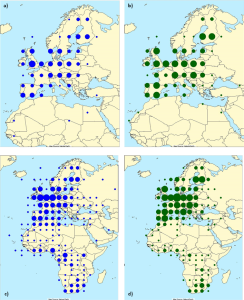
Re-encounters of Barn Swallows Hirundo rustica in the EURING data bank. (a) Ringing locations of birds recovered dead, (b) Ringing locations of birds recovered alive, (c) Finding locations of birds recovered dead, (d) Finding locations of birds recovered alive. Increasing symbol sizes show 1-10, 11-100, 101-1000, 1001-10,000 and 10,001-100,000 records.
A major aim of bird ringing is to provide information about the migration and movements of bird populations. However, little research has been devoted to improving quantitative inferences through large-scale spatial analyses. This represents a serious knowledge gap because robust information on geographical linkages of migratory populations throughout the annual cycle is necessary to understand the ecology and evolution of migrants and for the conservation and management of populations.
Here, we review recent developments and emerging opportunities for the quantitative study of movements of bird populations based on marked birds. Large-scale spatial analyses of ringing data need to account for spatiotemporal variation in re-encounter probability and the complexity of movement processes, including variability among individuals and populations in migration direction and distance.

